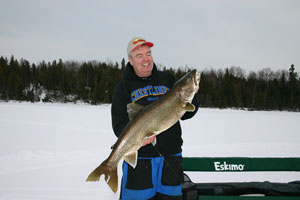There’s a real rush to be had when you go toe to toe with a big laker through the ice, and the result can be addicting. It’s more than just
the battle though; it’s everything that goes with it. Like the beauty of
a remote Canadian lake, and being all by yourself at times, and drilling
holes where no man has drilled before (at least this season). Combine
that with a superb fighting fish and you can get an idea of what heaven
might be like.
through the ice, and the result can be addicting. It’s more than just
the battle though; it’s everything that goes with it. Like the beauty of
a remote Canadian lake, and being all by yourself at times, and drilling
holes where no man has drilled before (at least this season). Combine
that with a superb fighting fish and you can get an idea of what heaven
might be like.
It’s also why the dedicated sometimes subject
themselves to extreme weather conditions like daytime temperatures that
stay well below zero. Team Crestliner members John Janousek and Tracy
Pogue of Bemidji, Minnesota have been bitten by the big laker bug and
make at least a couple trips every winter and have been on the ice with
lows in the thirty-five and forty below range. Pogue on the extreme:
“It’s a little tough, but you just deal with it and the fish don’t seem
to mind. Our best trip last year was darn cold but we caught a lot of
fish including a twenty-six pounder!”
Pro fisherman and guide Jeff “Gussie” Gustafson of
Kenora, Canada (1-807-468-7898) absolutely loves chasing down and
catching monster lakers and spends a good deal of the ice fishing season
in pursuit; “It starts the first of January and I can’t wait to get
going. It’s about as much fun as you can have, especially when you
actually see a big trout come in and circle your bait and then inhale
it!” Good lake trout water is gin clear and you can see down twenty
feet or more, and makes for some great viewing. “You’ll see fish on the
depth finder but you can also see some of the high riders if you look
down the hole. Last year over half of the fish we caught came up high
where we could literally see them. The fish use the ice to push up
schools of bait against, so don’t be afraid to spend some time working
the top ten feet or fifteen feet.”
When Gussie starts looking for lake trout he’ll
check out main lake structure like points and fast breaks, especially if
it’s close to real deep water; “Winter lakers are as active as they’ll
be all year and are usually biting, you just have to find them. They
also move around a lot so you better be mobile. I’ll set up on a spot
and maybe give it a half hour before moving on.”
Gussie’s go to bait is a 3 ˝ inch Northland Tackle
Slurpies Jiggin’ Tube in a Silver Shiner pattern. “The lakers are
chasing ciscoes and smelt and the plastic tube does a great job of
imitating what the fish are feeding on. You could use a smaller tube or
add some meat like a piece of sucker belly or a minnow, but most of my
bigger fish have come on pure plastic, especially the larger tubes.”
He’ll cover just about every depth and has caught
fish down to a hundred feet; “I’ve caught them extremely deep but most
of the fish come out of the forty to sixty foot range, even in much
deeper water. I’ll use a Marcum LX-5 to keep track of what’s going on
in deeper water and watch for chasers. Fish will come in and not always
take the bait right away, but if you can keep working them higher and
higher you just might get them go.”
The basic jigging technique includes lifting the
bait and letting it drop, and then waiting for it to settle out before
lifting it again. The tube will swing out on the lift and then turn
back and glide back in on the drop. If you’re getting stared down you
might try giving the bait a short pop or quiver, or keep doing what
you’re doing, whatever it takes.
Gussie uses standard walleye gear to get the job
done even though there are some specialized rods you could use; “My
heavier walleye spinning rods work just fine. I like to use spinning
gear because I can back reel when a fish makes a big run, and they’re
going to make plenty of runs. I’ve started using braided line a lot
when working deeper water because I can get a better hook set. I’ll
still use a leader though, which is usually eight or ten pound test
monofilament.”
Some of the best trout water that’s in range of us
that are stateside includes Whitefish Bay on Lake of the Woods, Crow
Lake near Nestor Falls, and Dryberry northeast of Sioux Narrows.
According to Gussie you have to travel another five hundred miles to
find anything that’s as good.
It’s probably not something you can do everyday
(unless you’re Gussie), but could do every year. I had heard about it
and heard about it and finally made the trip with John, Tracy, and
Gussie last season and is now part of an annual plan. See you on the
ice.


 through the ice, and the result can be addicting. It’s more than just
the battle though; it’s everything that goes with it. Like the beauty of
a remote Canadian lake, and being all by yourself at times, and drilling
holes where no man has drilled before (at least this season). Combine
that with a superb fighting fish and you can get an idea of what heaven
might be like.
through the ice, and the result can be addicting. It’s more than just
the battle though; it’s everything that goes with it. Like the beauty of
a remote Canadian lake, and being all by yourself at times, and drilling
holes where no man has drilled before (at least this season). Combine
that with a superb fighting fish and you can get an idea of what heaven
might be like.